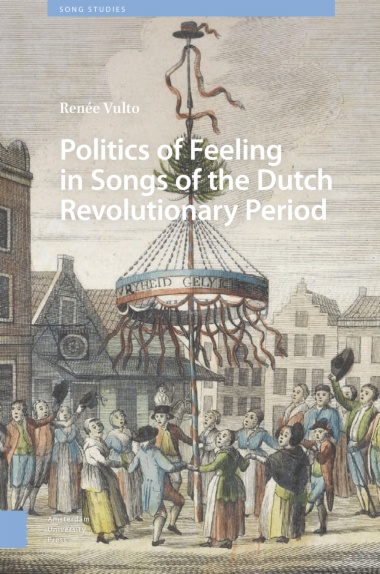This book sheds new light on the intertwined history of music and politics through an exploration of Dutch political songs. In the emotionally charged climate of the Dutch revolutionary period at the close of the eighteenth century, songs became a powerful voice, speaking directly to people’s bodies to engage them in political action. Emphasizing the performative nature of the songs and the interplay between imagination and embodied expression in singing practices, this book shows how beyond merely creating communities, the songs were also instrumental in mobilising, imagining, and affirming these collectives. It uncovers the diverse roles of these songs, showing how they were used to polarize and unite, to mourn and celebrate, and how they were employed to imagine and to embody togetherness throughout the Dutch revolutionary period, thereby creating a fixed repertoire of feelings on which various political regimes of that time relied.
- Cover
- Table of Contents
- Acknowledgements
- A Note on Language and Music
- Politics of Feeling in Songs of the Dutch Revolutionary Period
- Part I Activating Political Bodies
- 1. Songs of the Patriot Citizens
- Song and Drill
- Speaking to the Patriot Body
- All Patriot Citizens?
- Local Communities within a National Network
- Unity Makes Strength
- 2. Singing an Orangist Counterpoint
- Celebrating the Stadtholder
- Songs as Weapons
- Mobilizing the Counterrevolution
- Ridiculing the Other
- Part II Constructing Emotional Bonds
- 3. Singing Together in Exile
- Song as Space for Imagination
- Voicing Grief and Encouraging Hope
- Feelings of Exile
- 4. The Sound of Revolution
- Dancing Around the Liberty Pole
- Cheering for the New Nation
- Sounds of Fraternity
- Part III Legitimizing a New Order
- 5. Songs of a New Batavian Nation
- A Nation under Construction
- Affirmative Resonances
- Keeping the Fire of the Revolution Burning
- 6. Singing on the Stage of European Conflict
- Defending the Batavian Republic
- United in Victory
- United by Peace
- Affirming the Batavian Republic on the International Stage
- Conclusions: Listening to Singing Communities
- Mobilizing Politics
- Imagining Togetherness
- Affirming New Regimes
- Change and Continuity in Singing Communities
- Epilogue: Napoleonic Transformations and a Return to the Old Order
- Songs for the Streets
- New Songs to Old Tunes
- Bibliography
- List of songs
- List of tunes
- Index
- List of Illustrations
- 1. De Liedjes-Sangster, etching on paper, Carel Frederik Bendorp, 1782, Rijksmuseum Amsterdam. We see a fair at which a crowd has gathered around two women standing on a platform, singing and selling songs. Behind them is a painting (rolprent) on which a
- 2. Keeshonden dansen op muziek van de Duivel, etching and engraving, with letterpress text, 1787, Rijksmuseum Amsterdam.
- 3. Fragment of the eighth stanza of the Aria, Voor Zang, Viool en Bas op de Heeren Nieuwbakken Patriotten in the 1788 edition of the Oranje-Boom songbook. It shows how in the first line the word “Patriotten” is printed in italics, upside down, and in reve
- 4. Herstel van de vrijheid dankzij de Fransen, coloured drawing on paper, 1782, Rijksmuseum Amsterdam. In the drawing, we see two French soldiers talking to two women. One of the women is Liberty, together with one of the soldiers; she holds a liberty pol

